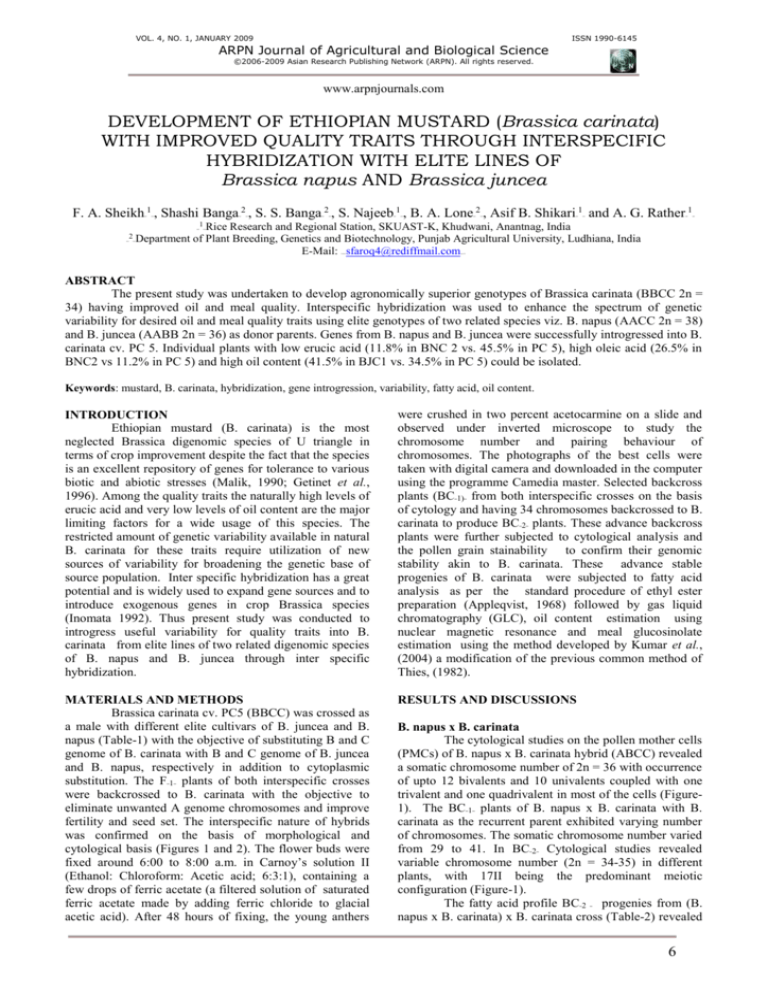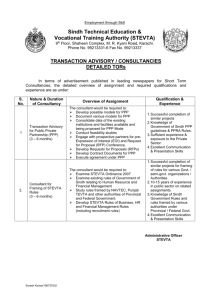
VOL. 4, NO. 1, JANUARY 2009
ISSN 1990-6145
ARPN Journal of Agricultural and Biological Science
©2006-2009 Asian Research Publishing Network (ARPN). All rights reserved.
www.arpnjournals.com
DEVELOPMENT OF ETHIOPIAN MUSTARD (Brassica carinata)
WITH IMPROVED QUALITY TRAITS THROUGH INTERSPECIFIC
HYBRIDIZATION WITH ELITE LINES OF
Brassica napus AND Brassica juncea
F. A. Sheikh 1 , Shashi Banga 2 , S. S. Banga 2 , S. Najeeb 1 , B. A. Lone 2 , Asif B. Shikari 1 and A. G. Rather 1
PPP
PPP
PPP
PPP
PPP
PPP
PPP
PPP
PPP
PPP
PPP
PPP
PPP
PPP
1
Rice Research and Regional Station, SKUAST-K, Khudwani, Anantnag, India
2 Department of Plant Breeding, Genetics and Biotechnology, Punjab Agricultural University, Ludhiana, India
E-Mail: sfaroq4@rediffmail.com
PPP
PPP
PPP
PPP
TUTUTU
UUUT TT
ABSTRACT
The present study was undertaken to develop agronomically superior genotypes of Brassica carinata (BBCC 2n =
34) having improved oil and meal quality. Interspecific hybridization was used to enhance the spectrum of genetic
variability for desired oil and meal quality traits using elite genotypes of two related species viz. B. napus (AACC 2n = 38)
and B. juncea (AABB 2n = 36) as donor parents. Genes from B. napus and B. juncea were successfully introgressed into B.
carinata cv. PC 5. Individual plants with low erucic acid (11.8% in BNC 2 vs. 45.5% in PC 5), high oleic acid (26.5% in
BNC2 vs 11.2% in PC 5) and high oil content (41.5% in BJC1 vs. 34.5% in PC 5) could be isolated.
Keywords: mustard, B. carinata, hybridization, gene introgression, variability, fatty acid, oil content.
INTRODUCTION
Ethiopian mustard (B. carinata) is the most
neglected Brassica digenomic species of U triangle in
terms of crop improvement despite the fact that the species
is an excellent repository of genes for tolerance to various
biotic and abiotic stresses (Malik, 1990; Getinet et al.,
1996). Among the quality traits the naturally high levels of
erucic acid and very low levels of oil content are the major
limiting factors for a wide usage of this species. The
restricted amount of genetic variability available in natural
B. carinata for these traits require utilization of new
sources of variability for broadening the genetic base of
source population. Inter specific hybridization has a great
potential and is widely used to expand gene sources and to
introduce exogenous genes in crop Brassica species
(Inomata 1992). Thus present study was conducted to
introgress useful variability for quality traits into B.
carinata from elite lines of two related digenomic species
of B. napus and B. juncea through inter specific
hybridization.
were crushed in two percent acetocarmine on a slide and
observed under inverted microscope to study the
chromosome number and pairing behaviour of
chromosomes. The photographs of the best cells were
taken with digital camera and downloaded in the computer
using the programme Camedia master. Selected backcross
plants (BC 1) from both interspecific crosses on the basis
of cytology and having 34 chromosomes backcrossed to B.
carinata to produce BC 2 plants. These advance backcross
plants were further subjected to cytological analysis and
the pollen grain stainability to confirm their genomic
stability akin to B. carinata. These advance stable
progenies of B. carinata were subjected to fatty acid
analysis as per the standard procedure of ethyl ester
preparation (Appleqvist, 1968) followed by gas liquid
chromatography (GLC), oil content estimation using
nuclear magnetic resonance and meal glucosinolate
estimation using the method developed by Kumar et al.,
(2004) a modification of the previous common method of
Thies, (1982).
MATERIALS AND METHODS
Brassica carinata cv. PC5 (BBCC) was crossed as
a male with different elite cultivars of B. juncea and B.
napus (Table-1) with the objective of substituting B and C
genome of B. carinata with B and C genome of B. juncea
and B. napus, respectively in addition to cytoplasmic
substitution. The F 1 plants of both interspecific crosses
were backcrossed to B. carinata with the objective to
eliminate unwanted A genome chromosomes and improve
fertility and seed set. The interspecific nature of hybrids
was confirmed on the basis of morphological and
cytological basis (Figures 1 and 2). The flower buds were
fixed around 6:00 to 8:00 a.m. in Carnoy’s solution II
(Ethanol: Chloroform: Acetic acid; 6:3:1), containing a
few drops of ferric acetate (a filtered solution of saturated
ferric acetate made by adding ferric chloride to glacial
acetic acid). After 48 hours of fixing, the young anthers
RESULTS AND DISCUSSIONS
BBB
BBB
BBB
BBB
BBB
BBB
B. napus x B. carinata
The cytological studies on the pollen mother cells
(PMCs) of B. napus x B. carinata hybrid (ABCC) revealed
a somatic chromosome number of 2n = 36 with occurrence
of upto 12 bivalents and 10 univalents coupled with one
trivalent and one quadrivalent in most of the cells (Figure1). The BC 1 plants of B. napus x B. carinata with B.
carinata as the recurrent parent exhibited varying number
of chromosomes. The somatic chromosome number varied
from 29 to 41. In BC 2 Cytological studies revealed
variable chromosome number (2n = 34-35) in different
plants, with 17II being the predominant meiotic
configuration (Figure-1).
The fatty acid profile BC 2 progenies from (B.
napus x B. carinata) x B. carinata cross (Table-2) revealed
BBB
BBB
BBB
BBB
BBB
BBB
6
VOL. 4, NO. 1, JANUARY 2009
ISSN 1990-6145
ARPN Journal of Agricultural and Biological Science
©2006-2009 Asian Research Publishing Network (ARPN). All rights reserved.
www.arpnjournals.com
a significant increase in mean oleic acid and linoleic
content over the check PC5. Besides increase in the mean
value, range of variability also enlarged with different
lines and individual plants containing up to 26.5 per cent
oleic acid and 30.4 per cent linoleic acid (BNC2) in
comparison to 11.2 per cent and 18.2 per cent respectively
of check variety (PC5). The eicosenoic acid content of the
introgression lines was either at par or was marginally
higher than the check (PC5). The mean erucic acid content
of all the lines showed a significant decrease as compared
to PC5, revealing successful introgression of genes from
B. napus parent for low erucic acid content. Individual
plants having a recorded decrease up to 11.8 per cent
erucic acid were identified. Erucic acid content in B. napus
is controlled by two genes (Harvey and Downey, 1964)
suggesting the presence of one gene in each of it’s A and
C genomes which act in additive manner and display no
dominance. Interspecific hybrid between high erucic acid
B. carinata parent (B + B + C + C + ) and zero erucic acid B.
napus parent (A - A - C - C - ) would be of the genome
constitution (A - B + C + C - ). Normally A and B genomes
do not show allosyndetic pairing in haploid state
(Mizushima 1950, Olsson 1960) when such hybrids are
selfed after one backcross, BC 1 F 2 plants of constitution
B + B + C + C - , B + B + C - C - with C genome free of erucic
acid are possible. Fernandez-Martinez et al., (2001) also
reported genetic stock 25 x -1 of Ethiopian mustard
characterized by seed oil with essentially no erucic acid
from interspecific crosses of selected lines of Ethiopian
mustard, rapeseed and Indian mustard. The oil content of
the progenies BNC5 and BNC2 showed an increase in the
mean value over the check (PC5) with individual plants in
these lines showing significantly high oil content of 41.0
per cent and 38.6 per cent, respectively. This could be due
to gene introgression from B. napus parent which contains
high oil content (43.4%). Mean glucosinolate content in
the progeny BNC 4 (93.5 ± 10.0 µ moles/g defatted meal)
was lower than the check (107.5 µ mole per g of defatted
meal). However, individual plants giving very low
glucosinolate content (70.5 µ moles per g of defatted
meal) have been identified in the line BNC3. Previously
successful introgression of desirable alleles for low
glucosinolate in mustard from B. rapa was made through
hybridization followed by backcross and selfing (Banga,
1996)
PPP
PPP
PPP
PPP
PPP
PPP
PPP
PPP
PPP
PPP
PPP
PPP
PPP
PPP
PPP
PPP
PPP
PPP
PPP
PPP
PPP
PPP
BBB
PPP
P PP
PPP
PPP
PPP
PPP
PPP
PPP
PPP
PPP
PPP
PPP
PPP
PPP
PPP
PPP
PPP
BBB
BBB
BBB
PPP
B. juncea x B. carinata
In B. juncea x B. carinata the cytological analysis
hybrid (ABBC) confirmed the expected somatic
chromosome number of 2n = 35 with upto 12 bivalents
(Figure-2). The BC 1 plants exhibited varying number of
chromosomes from 28 to 35. Upto 17 IIs were observed in
BC 1 of B. juncea x B. carinata whereas 12II +1III + 3I
were the predominant meiotic configuration. Meiotic
analysis of the representative plants of each BC 2 progeny
revealed chromosome no. 2n = 34 and high (16.88) mean
bivalent frequency (Figure-2).
The fatty acid profile of BC 2 progenies of (B.
juncea x B. carinata) x B. carinata revealed a significant
increase of oleic acid content in all the lines over the
BBB
BBB
BBB
check, PC5 (Table-3). Individual plants containing oleic
acid content up to 23.9 per cent were identified in the
progeny line BJC8. Eicosenoic acid also showed a slight
decrease in majority of the progenies whereas mean erucic
acid content was lower than PC5 in all the progenies. The
individual plants containing as low as 17.0 per cent erucic
acid (BJC8) against 45.9 per cent in PC5 indicated
successful and stable transfer of genes governing erucic
acid from canola mustard parent (NUDH-YJ-4). This
clearly indicated stable expression of introgressed genes
for low erucic acid content from NUDH-YJ-4. Brassica
carinata when crossed with zero erucic acid lines of B.
juncea followed by selfing and selection for lower erucic
acid content led to reduced erucic acid content (Fernandez
and Alonso, 1988)
Kirk and Hurlstone, (1983) reported that erucic
acid content in B. juncea is controlled by two independent
genes which act in an additive manner and display no
dominance and concluded that one gene could be present
in each of A and B genomes. The interspecific hybrid
between high erucic acid B. carinata (B + B + C + C + ) and
zero erucic acid B. juncea (A - A - B - B - ) would be of the
genomic constitution (B + B - C + A - ). The A and C
genomes in the interspecific hybrid are in the haploid state
and may, therefore, pair and subsequently exchange
genetic material (Attia and Roebbelen, 1986). This is
expected to result in the formation of zero erucic acid B C - gametes in the interspecific hybrid. When such B - C gametes are fertilized with B + C + gametes of high erucic
acid backcross parent, then double heterozygous BC 1
plants (B + B - C + C - ) are expected to segregate into
different types following selfing with some of them free
of erucic acid. Previously Getinet et al., (1994) also
reported a significant decrease in erucic acid content in B.
carinata in BC 4 F 3 generation from a cross of B. carinata
x B. juncea (zero erucic acid). The mean oil content
showed a significant increase in the line BJC1 (39.1 ±
0.9%) over the check (34.3%). This line also depicted
excellent variability with some plants showing as high as
41.5 per cent oil content, indicating a clear effect of gene
introgression. Glucosinolate content recorded a significant
decrease in most of the lines over the check (PC5). The
excellent variability for low glucosinolate was present in
the lines BJC30, BJC24 and BJC8 with 60.2-95.0, 73.2127.3 and 79.5-90.3 µ moles per g of defatted meal,
respectively, showing the effect of introgressed genes
from B. juncea parent (NUDH-YJ-4). Earlier Getinet et
al., (1997) were successful in identifying plants that
contained only 20 µ mole of 2 propenyl glucosinolate
from (B. carinata x B. juncea) x B. carinata combination.
This constituted an 85% reduction compared with levels in
B. carinata parent.
PPP
PPP
PPP
PPP
PPP
PPP
PPP
PPP
PPP
PPP
PPP
PPP
PPP
PPP
PPP
PPP
PPP
PPP
PPP
PPP
PPP
PPP
PPP
PPP
PPP
PPP
PPP
PPP
PPP
PPP
PPP
PPP
PPP
PPP
PPP
PPP
BBB
PPP
PPP
PPP
PPP
BBB
PPP
BBB
PPP
BBB
PPP
BBB
PPP
BBB
BBB
BBB
BBB
BBB
BBB
CONCLUSIONS
The present study was successful in developing
diverse B. carinata types having desired variability
introgressed from elite, related species for fatty acid
composition, oil content and meal quality. The use of these
in lines in breeding programme may result in the
7
VOL. 4, NO. 1, JANUARY 2009
ISSN 1990-6145
ARPN Journal of Agricultural and Biological Science
©2006-2009 Asian Research Publishing Network (ARPN). All rights reserved.
www.arpnjournals.com
development of canola quality cultivars of B. carinata
having high oil content and desired morphotypes.
REFERENCES
complex formation between glucosinolates and
tetrachloropalladate (II) using ELISA Reader. J. Food Sci.
Technol. 41: 63-65.
Appleqvist LA. 1968. Rapid methods of lipid extraction
and fatty acid ester preparation for seed and leaf tissue
with special remarks on preventing the accumulation of
lipid contaminants. Ark. Kenci. 28: 351-370.
Malik RS. 1990. Prospects for Brassica carinata as an
oilseed crop in India. Exp. Agric. 26: 125-129.
Attia T, Roebbelen G. 1986. Cytogenetic relationship
within cultivated Brassica analyzed in amphidiploids from
the three diploid ancestors. Can. J. Genet. Cytol. 28: 323329.
Mizushima U. 1950. Karyogenetic studies of species and
genus hybrids in the tribe Brassiceae of Cruciferae.
Tohoku. J. Agr. Res. 1: 1-14.
Olsson G. 1960. Species cross within the genus Brassica I.
Artificial Brassica juncea Coss. Hereditas. 46: 171-220.
Banga S. K. 1996. Breeding for oil and meal quality. In:
Chopra V L and Prakash S (eds) Oilseed and Vegetable
Brassicas: Indian Perspective. pp. 234-249. IBH
Publishing Co. Pvt. Ltd, New Delhi.
Thies
W.
1982.
Complex-formation
between
glucosinolates and tetrachloropalladate (II) and its
utilisation in plant breeding. Fette. Seifen. Anstrichm. 84:
338-342.
Fernandez-Martinez JM, Rio M Del, Velasco L,
Dominguez J, Haro A De. 2001. Registration of zero
erucic acid Ethiopian mustard genetic stock 25x-1. Crop
Sci. 41: 282.
Zou N., Dart P.J. and Marcar N.E. 1995. Interaction of
salinity and rhizobial strain on growth and N 2 -fixation by
Acacia ampliceps. Soil Biology and Biochemistry. 27:
409-413.
Fernandez-Serrano O, Alonso LC. 1988. Breeding
Brassica carinata for low erucic acid contents. Cruciferae
Newslett. 13: 32-33.
Table-1. Genotypes of B. napus, B. juncea, B. carinata
and B. nigra used in the interspecific hybridization.
Species
Genotypes
Particulars
Getinet A, Rakow G, Downey RK. 1996. Agronomic
performance and seed quality of Ethiopian mustard in
saskatchewan. Can.J. Pl. Sci. 76: 387-392.
B. napus
NHO 7-10
‘0’ C22:1
NHO 7-12
‘0’ C22:1
BBB
BBB
NHO 7-13
‘0’ C22:1
Getinet A, Rakow G, Raney JP, Downey RK. 1994.
Development of zero erucic acid Ethiopian mustard
through an interspecific cross with zero erucic acid
Oriental mustard. Can. J. Pl. Sci. 74: 793-795.
NHO 7-14
‘0’ C22:1
NHO 7-15
‘0’ C22:1
NHO 7-16
‘0’ C22:1
Getinet A, Rakow G, Raney J P, Downey R K. 1997.
Glucosinolate content in interspecific crosses of Brassica
carinata with B. Juncea and B. napus. Plant Breed. 116:
39-46.
MHO 18-1-21
Canola
MHO 18-1-26
Canola
MHO 18-1-35
Canola
MHO 18-1-36
Canola
MHO 18-1-184
Canola
GSC 5
Canola
NUDH YJ-4
Canola
NJHO 3-10A
‘0’ C22:1
NJHO 3-25
‘0’ C22:1
Mozambique
High C22:1
FRG 1
High C22:1
Indian nigra
High C22:1
PC 5
High C22:1
Harvey BL, Downey RK. 1964. The inheritance of erucic
acid content in rapeseed (Brassica napus). Can. J. Pl. Sci.
44: 104-111.
B. juncea
Inomata N. 1992. Embryo rescue techniques for wide
hybridization.In. Labana KS, Banga SS, Banga
SK(eds).Breeding oilseed Brassicas. Narosa Publishing
House, New Delhi, India. pp. 94-107.
Kirk JTO, Hurlstone HD. 1983. Variation and inheritance
of erucic acid in Brassica juncea. Z. Pflan. zenzuchtg. 90:
331-338.
B. nigra
B. carinata
Kumar S, Yadav SK, Chauhan JS, Singh AK, Khan NA,
Kumar PR. 2004. Total glucosinolate estimation by
8
VOL. 4, NO. 1, JANUARY 2009
ISSN 1990-6145
ARPN Journal of Agricultural and Biological Science
©2006-2009 Asian Research Publishing Network (ARPN). All rights reserved.
www.arpnjournals.com
9
VOL. 4, NO. 1, JANUARY 2009
ISSN 1990-6145
ARPN Journal of Agricultural and Biological Science
©2006-2009 Asian Research Publishing Network (ARPN). All rights reserved.
www.arpnjournals.com
Table-2. Mean and range of fatty acid composition, oil and glucosinolate content in (B. napus x B. carinata) BC2.
Fatty acid composition (%)
Linolenic
Oleic
Linoleic
acid
acid
acid
Erucic acid
Oil content
(%)
Glucosinolate
(µ moles/g
defatted meal)
12.6±0.3
30.5±0.4
35.1±0.8
99.0±9.0
(11.6-15.6)
(11.9-13.5)
(30.0-31.3)
(32.9-37.9)
(84.2-115.2)
25.8±1.0
12.5±0.4
10.8±0.3
24.0±1.4
35.3±0.3
109.7±7.0
(11.9-26.5)
(19.3-30.4)
9.8-14.4)
(8.9-12.6)
(11.8-32.0)
(33.8-38.6)
(80.5-118.9)
0.7±0.2
16.4±0.8
23.7±1.1
14.7±0.5)
10.0±0.3
29.5±0.3
31.9±0.5
117.7±7.9
(3.9-6.3)
(0-1.0)
(13.2-19.1)
(20.9-25.6)
(12.2-16.2)
(9.2-11.4)
(28.5-31.0)
(29.9-34.7)
(70.5-130.7)
6.3±0.4
0.7±0.3
20.5±1.7
24.0±1.0
13.0±0.9
11.5±0.4
24.0±2.8
34.4±0.5
93.5±10.0
(5.2-7.3)
(0.1-1.7)
(16-25.7)
(21.5-27.8)
(9.7-14.5)
(10.4-12.4)
(17.4-32.2)
(33.2-36.0)
(73.6-105.6)
7.0±0.4
1.6±0.2
22.3±1.1
21.7±0.4
11.9±0.5
12.7±0.3
22.7±1.1
39.2±0.7
124.6±6.0
(6.2-7.8)
(0.8-1.9)
(21.0-23.9)
(19.7-23.5)
(9.8-14.1)
(11.6-13.8)
(17.3-32.3)
(37.4-41.0)
(118.3-134.2)
PC5 (check)
3.5
0.6
11.2
18.1
11.1
9.6
45.9
34.3
107.5
NHO 7-10
5.1
1.3
67.5
18.3
6.6
0.3
0.6
43.4
80.0
Entries
Palmitic
acid
BNC 1
4.8±0.3
0.8±0.3
16.3±0.4
21.0±0.4
(4.2-5.9)
(0 – 1.9)
(15.2-17.4)
5.6±0.4
0.8± 0.2
(3.5-6.8)
BNC 2
BNC 3
BNC 4
BNC 5
Eicosenoic
acid
13.9±0.6
(19.9-22.8)
20.4±1.2
(0-2.0)
4.8±0.3
Stearic
acid
Figures in parenthesis indicate range
10
VOL. 4, NO. 1, JANUARY 2009
ISSN 1990-6145
ARPN Journal of Agricultural and Biological Science
©2006-2009 Asian Research Publishing Network (ARPN). All rights reserved.
www.arpnjournals.com
Table-3. Mean and range of variability for fatty acid composition, oil and glucosinolate content in BC 2 progenies of the cross, B. juncea x B. carinata.
BBB
Progenies
BJC 1
BJC 8
BJC 9
BJC 21
BJC 23
BJC 24
BJC 28
BJC 29
BJC 30
BJC 31
PC5 (Check)
NUDH-YJ-4
BBB
Palmitic
acid
5.2±0.2
(4.9 - 5.7)
7.0±0.2
(6.5 - 7.5)
5.4±0.5
(4.2 - 6.5)
Stearic
acid
0.4±0.1
(0 -0.7)
1.2±0.4
(0 -1.9)
0.3±0.2
(0-0.8)
Fatty acid composition (%)
Oleic
Linoleic
Linolenic
acid
acid
acid
17.4±1.4
24.8±0.5
16.4±0.8
(14-20.1)
(23.5-26.9)
(14.9-18.7)
20.3±1.8
28.7±0.7
12.6±0.9
(15.8-23.9)
(26.7-30.4)
(11.2-14.5)
12.8±0.4
23.5±0.2
14.3±0.5
(11.3-14.2)
(21.4-25.5)
(13.3-15.5)
4.7±0.3
(4.3-5.3)
4.0±0.1
(3.7-4.5 )
5.4±0.2
(4.6-6.8)
0.2±0.2
(0 -0.6)
0.3±0.2
(0 -0.7)
0.4±0.1
(0 -1.2)
18.2±0.6
(16.6-19.9)
15.5±1.4
(12.8-18.0)
16.8±0.7
(12.5-20.7)
28.2±1.1
(26.4-29.6)
25.7±0.5
(24.4-26.9)
23.9±1.3
(19.1-30.6)
13.9±0.4
(12.5-15.2)
12.9 ±0.4
(11.2-14.4)
14.3±0.5
(10.0-15.6)
9.0±0.3
(7.7-9.9)
8.6±0.3
(8.0-9.2)
9.3±0.4
(7.7-10.7)
25.8±0.8
(25-26.6)
33.0±2.5
(29.4-37.9)
29.9±1.3
(26.4-39.2)
30.4±0.8
(28.6-32.9)
34.0±1.3
(31.0-37.1)
35.0±0.7
(32.7-40.7)
93.9±1.2
(90.8-97.1)
103.4±19.7
(80.7-126.2)
94.6±9.4
(73.2-127.3)
5.6±0.3
(4.7-6.3)
4.8±0.5
(3.7-6.8)
3.8±0.3
(3.2-4.8)
0.6±0.2
(0 -1.3)
0.4±0.1
(0 -1.2)
0.3±0.1
(0 - 0.7)
15.7±1.8
(12.9-22.5)
13.7±0.5
(9.3-22.5)
18.0±2.5
(13.6-22.3)
22.3±0.5
(20.5-25.1)
22.4±0.8
(19.3-25.2)
23.2±0.6
(21.9-25.2)
13.9±0.4
(12.9-15.9)
14.4±0.3
(13.5-15.4)
13.4±0.5
(12.7-14.3)
11.0±0.6
(9.5-13.2)
9.0±0.6
(6.7-11.0)
11.6±0.3
(10.0-12.9)
30.6±1.1
(27.9-34.3)
35.3±0.9
(32.8-40.3)
29.7±2.4
(27.8-35.6)
35.6±0.6
(33.7-37.8)
32.9±0.6
(29.4-35.1)
33.9±1.0
(31.6-37.4)
107.7±6.5
(82.7-131.1)
100.0±6.9
(83.4-125.2)
81.4±7.4
(60.2-95.0)
6.4±0.3
(5.7-6.7)
3.5
5.2
0.6±0.4
(0.5-1.5)
0.6
1.5
18.9±1.2
(17.0-21.2)
11.2
44.3
25.7±1.5
(22.4-27.5)
18.1
34.9
13.5±0.3
(12.2-14.9)
11.1
10.7
11.1±1.2
(8.8-13.2)
9.6
2.8
23.8±2.9
(18.2-27.8)
45.9
0.2
36.0±0.8
(34.4-38.2)
34.3
45.1
95.5±8.6
(82.2-108.3)
107.6
28.3
Eicosenoic
acid
8.6±0.3
(7.9-9.2)
9.8±0.8
(7.0-11.3)
8.8±0.9
(6.9-10.9)
Erucic
acid
27.2±1.2
(25.7-30.8)
20.4±1.7
(17.0-24.9)
34.9±1.3
(31.9-37.8)
Figures in parenthesis indicate range
11
Oil content
(%)
Glucosinolate
(µ moles/g
defatted meal)
39.1±0.9
(37.2-41.5)
35.5±0.2
(34.9-36.0)
35.4±1.3
(31.8-38.7)
92±3.7
(84.4-97.4)
83.4±3.4
(79.5-90.3)
97.1±3.7
(89.7-101.8)
VOL. 4, NO. 1, JANUARY 2009
ISSN 1990-6145
ARPN Journal of Agricultural and Biological Science
©2006-2009 Asian Research Publishing Network (ARPN). All rights reserved.
www.arpnjournals.com
A
B
D
C
E
G
F
H
I
Figure-1. Meiotic configuration in the PMCs of B. napus x B. carinata hybrid (A-B), BC 1 (C-F) and BC 2 (G-I)
generations. A. 11II+ 1IV+10I; B.12II+1III+9I; C.10II+9I; D11II+13I; E.12II +17I; F.16-13 distribution at
anaphase; G.15II+5I; H.17II; I.18-16 distribution at anaphase.
BBB
BBB
BBB
BBB
BBB
BBB
12
VOL. 4, NO. 1, JANUARY 2009
ISSN 1990-6145
ARPN Journal of Agricultural and Biological Science
©2006-2009 Asian Research Publishing Network (ARPN). All rights reserved.
www.arpnjournals.com
A
D
G
B
C
E
F
H
I
Figure-2. Meiotic configuration in PMCs of Brassica juncea x Brassica carinata hybrid (A-B), BC 1 (C-F) and BC 2
(G-I). A.11II+13I; B. 12II+1IV+7I; C. 12II+1III+3I; D.14II+1III+3I; E.13II+1IV+4I; F. 17II; G.16II+2I;
H.17II; I.17-17 distribution at anaphase.
BBB
BBB
BBB
BBB
BBB
13








